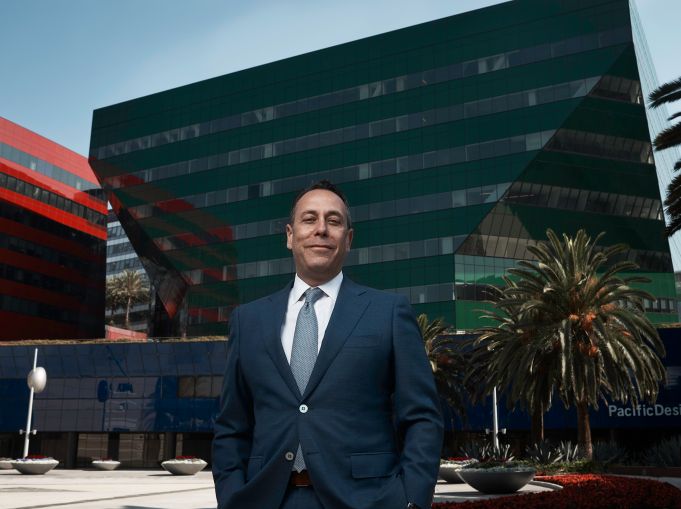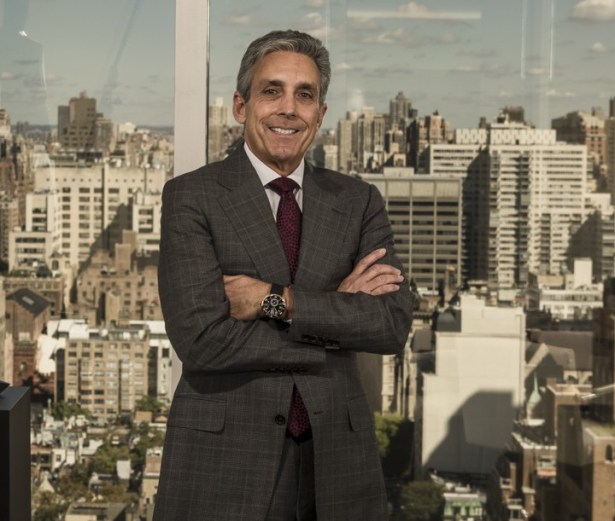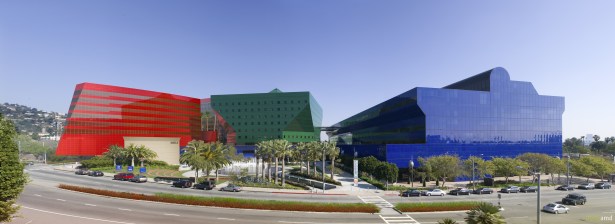Finishing (and Filling) Cohen Brothers’ Pacific Design Center
By Alison Stateman November 26, 2018 11:37 am
reprints
It’s hard to imagine today, but when Cohen Brothers Realty Corporation bought the Pacific Design Center in West Hollywood in 1999, the landmark property was struggling to find tenants. The complex, designed by Cesar Pelli, started with the Blue Building—known as the Blue Whale completed in 1975—followed by the Green Building in 1988 and finally the ground-up construction of the Red Building, completed by Cohen in 2013.
It simply had too much square footage devoted to showrooms, Charles S. Cohen, the president and chief executive, and Marc Horowitz, the senior vice president and national director of leasing at Cohen Brothers, explained over lunch at Wolfgang Puck’s restaurant red|seven in the Red Building last month.
“The Green Building was the beginning of the problem here. There was too much capacity. There is no one city in this world that can handle more than 500 to 600,000 square feet of high-level showrooms,” Cohen said. “That’s why we repurposed it.”
Despite the complex’s striking design, and revamp, which involved adding around 80 windows and office lobby, among other amenities, to the Green Building to the tune of around $70 million and creation of the Red Building to complete Pelli’s original vision, local media chided the Red Building for only starting to sign tenants in 2015. The first among them, as the Los Angeles Times reported, included media and tech company Whalerock Industries and high-end retailer AllSaints. Curbed LA blamed Cohen’s pickiness about what tenants he signed as well as asking for some of the highest rents on the market as a deterrent. However, Cohen takes the long view.
“It took me 12 years to change the entire roots, to build the Red Building” he said, “and we’re just finishing up the leasing now. It takes time.”
And, as far as being picky, that too is part of the duo’s overall approach with the PDC and other high-profile properties Cohen Brothers owns including the Decoration & Design (D&D) Building in Manhattan and Design Center of the Americas (DCOTA) in South Florida.
Horowitz said they sought tenants that can “feed off each other, that are in similar worlds, so it brings business to the place with tenants that are all sort of aligned.”
High-profile deals of late include WeWork (WE)’s lease expansion, in which the coworking giant will take additional 93,500 square feet at the complex in addition to 70,000 square feet they signed onto last year. Indie-entertainment production company A24 is planning to relocate to the Red Building early next year, with Imagine Entertainment’s creative incubator to occupy part of the WeWork space.
Today, only “scraps” of the complex’s total 1.6 million square feet remain, Horowitz said. Cohen, 63, and Horowitz, 47, described the process of entering the West Coast market and making landmark properties like the PDC accessible and attractive to modern-day tenants with Commercial Observer.

Commercial Observer: When did you start thinking about coming to Southern California and why?
Charles Cohen: Mainly because of the Design Center. I had bought the D&D building in New York in October of ‘96. I always like to educate myself when I do something new. I came out here for a design conference that they have every year and I was just knocked out by the scale of the architecture. At that time, the center was an asset for a large pension fund and I was able to pursue it when they put it on the market.
The Red Building was a parking lot so that was something I did from the beginning. When I first came here the Green Building had one floor of office tenants and eventually it was completely converted to office except for the ground floor. Marc came along when I was working on the Red Building and the leasing.
Are there certain types of tenants that you sought for the PDC?
Marc Horowitz: I think Charles had a clear vision for this property, didn’t you?
CC: Yes. This city has always been known as a creative city. West Hollywood prides itself on that. Early on we were one of the pioneers of creative office space by taking property that was originally intended for another use and repurposing it and adapting it to today’s work style and work force. Things are so different today, with coworking.
As I mentioned earlier about learning the business, learning the neighborhood, learning the real estate, I always believed that for real estate to be successful, it’s got to connect to the various communities within which it exists. Here it was the design community, the entertainment industry, the charitable organization industry. So, we wanted this to feel welcoming and to remove barriers wherever we could.
MH: In my eyes when I came out here and I looked at this building I said: It screams entertainment, it screams everything that is the creative office user that fits into this area. It’s kind of taken on a life of its own, the tenant roster.
CC: This is becoming a hub and recognizing what the building needs to have to keep people engaged while they are here so they are productive. So early on, we created a fitness center, we have restaurants with Wolfgang Puck right now. We went into the food truck business. I picked up the kiosk on Melrose [Avenue] so the idea was to have reasons that people could stay here. We have a relationship with the museum out on the plaza.
MH: There’s a 365-seat Silver Screen movie theater here. There’s screening rooms being built, there’s conference centers. It’s its own universe. You come onto this campus and everything you need is here, so that makes it unique and different than any other office building.
Is there a difference in terms of how it works out here from the East Coast in terms of leasing or in the tenants you’re trying to get?
MH: What I’ve found in this market that is different is the need to really ingratiate myself into this community, the broker community in particular. There’s a handful of 15 to 20 brokers doing 90 percent of the business in this market. This is a very unique and intimate market, considering how spread out it is.
Did you find it difficult to break in?
MH: One of my strong points is I come to each market and I figure out ways to get in front of these different brokers and become partners with them. The buildings I consider my own. I look at them as if they are my own house. Who do I want in my house, how do I want my house to look and feel? If you think about it that way and you can develop the relationships, the rest of it falls into place.
CC: What’s been so successful for us is [Marc’s] ability to go into a market that’s not a New York City market—for instance Westchester County, which is not Manhattan, South Florida, Southern California. Wherever he has gone to tackle a leasing project, he completely immerses himself in the local brokerage community and tenant community and he is able to make a lot of progress and rent a lot of space though just hard work and commitment.
MH: We have a similar work ethic. I’m never satisfied. I’ve got a sports personality. I can’t sit back and relax and wait for business to come to me. I want to be put on the same playing field as everybody else. And I’ll rise to the top. I guess I’m a deal junky.
Are there certain types of tenants that you avoid?
CC: I think that we are very good at curating the right tenant mix and making sure the people who are here have a creative business aspect to what they are doing.
MH: Tenants that can feed off each other, that are in similar worlds, so it brings business to the place with tenants that are all aligned.
CC: Of course, the people who don’t have the right credit profile. Credit is very important to us. We’ve turned down quite a few people.
Do you have any other plans for development in this market, the West Coast market, and submarket of West Hollywood?
CC: Yes, we’ve been eyeing the site next door for a long time. The Sheriff’s station and the bus station. We’ve had discussions with the MTA and the Sheriff’s office for a long time. There’s a study about a Metro station. We’ve kind of put that opportunity on hold for now.
What were you interested in doing? Creative? Office?
CC: Office, hotel, retail.

Are you also looking at other places in LA or out West? Any other markets?
CC: I’ve been looking on the East side of L.A. for a theater, to do a theater in the Los Feliz, Silverlake area.
Like what you did with the Quad in New York? [Cohen recently revamped the theater.]
CC: Right, larger scale though.
How would you describe your work dynamic?
MH: It’s changed over the years. I’d been in this business for 15 years before I came here and I considered myself a seasoned veteran. I can’t tell you how much I’ve learned working alongside Charles. I’ve morphed into something else because he does things in his own way.
What changed for you?
MH: My way of thinking. Like I said, I know in my heart these are all Charles’ buildings, but when I’m out negotiating, out there looking for the right person, it’s my building. I think of it just like an owner would.
CC: For a real estate person to be successful, they need to think like an owner.
When you came to L.A., were there certain buildings or architects that especially excited you?
CC: I came to L.A. at a personal place in my life where I was going through a very tough period of time, emotionally. I was separated. I was going through a divorce. My older kids were younger and I needed to be able to balance spending time with them and also pursuing opportunities that would help me define who I became and who I am.
When I came out here it was so far away and so different from New York that it allowed me to utilize my experience from New York and apply it to a really different set of assumptions and territory and different people with different interests.
And L.A.’s always been a hot bed of architectural design, originality. If you look at the big design movements that have come through the United States, they’ve really blown from West to East. So, this was a natural place for someone who appreciated design to feel comfortable and excited about what’s around. I remember early on the talk of the town was the Gehry Disney Concert Hall, and now, the most recent is the Broad Museum, so there’s always these iconic projects that define L.A. architecture at any point in time.
When Cesar Pelli designed the Blue Building it was so revolutionary that people didn’t know what to make of it. They called it the Blue Whale.
This building [Red Building] and this complex of buildings could not really exist anywhere other than here. You know Paris has the [Centre Georges] Pompidou museum which is a little bit like this. Wherever you have something like this, it kind of shouts, “Hey, look at me, I’m different.” And what we tried to do is to connect that feeling of difference between the building and the community by connecting the building, opening doors, removing barriers, creating lecture halls for the Green Building, and we created a state of the art screening room for the studios.
We’re bringing hundreds of people in almost daily for something here. It’s an indirect way of marketing the showrooms themselves. When you walk through here, it’s sort of a museum of the living in a way. What is a design center? What is a trade property? A trade property is a building that houses businesses in the same business and it’s a uniquely American idea. We go out of our way to send a message to the community that we welcome design professionals and design enthusiasts.
Is there something about trade and design that is especially attractive?
CC: Yes. There’s only one in each of the city’s that can manage this. Not multiple design centers, particularly in most marketplaces. Remember, with real estate, besides location, you want to be unique. In any business to reach a level of achievement, you need to have a niche. So, what’s the niche? This is not an office building. It’s an out-of-this-world creative office building. It’s not just a shopping mall for people that want to buy furniture, it’s a design center and it’s all about design, events, there are all kinds of reasons designers would come here.
When you went about leasing it, how was that process like?
CC: Hard, hard.
MH: When you walk into a building and you’re an office tenant coming to look at that space and you’re looking at that building, “Wait, I don’t understand, how do I fit into this?” This is not a natural, like walking into a Class A office building, though it is Class A. It’s getting that deal moving and once it starts moving it’s a lot easier. It’s ingratiating yourself into the market with the tenants, with the brokers, with the people that are the dealmakers and making them your allies. Making them a part of our team as much as they are out there for their own needs.
Subscribe here to CO’s Los Angeles Weekly Newsletter for more interviews like this.


